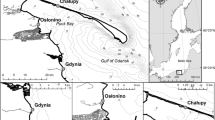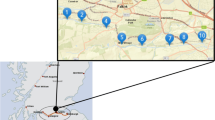Abstract
The river Elbe has been one of the most contaminated rivers with regard to mercury for many years. In 1991 a length-profile has been measured for mercury and methylmercury (CH3Hg+) from Obristvi, Czech Republic, to the German bight. Total mercury has been measured by cold vapor atomic absorption spectrometry (CVAAS). The organo mercury compounds have been separated by high performance liquid chromatography (HPLC) connected on-line to an atomic fluorescence spectrometer (AFS) by a continuous flow-system. Total mercury up to 120 mg Hg+/kg and CH3Hg+ concentrations up to 130 μg CH3 Hg+/kg could be detected in special sites. The formation of CH3Hg+ in sediments can be caused besides the methylation of mercury, by sulphate reducing or methanogenic bacteria and transmethylation reactions with organometals. Atmospheric mercury concentrations have been measured at three different European sites. Samples have been collected on goldcoated glass balls or on quartz wool, respectively. After thermal desorption mercury has been determined using the two step amalgamation technique with AFS detection. Compared to natural background concentrations of total gaseous mercury (TGM), slightly increased levels could be detected at a rural site in Germany. This increase can probably be explained by long-range transport processes. Within the vicinity of a inactivated mercury production plant high concentrations of up to 13.5 ng/m3 particle associated mercury (Hgpart) have been detected. Consequently, dry deposition of mercury in the particulate form can intensify the total deposition flux close to Hg-emitting sources.
Similar content being viewed by others
References
Adriano DC (1986) Trace elements in the terrestrial environment, Chapter 9. Springer, Berlin Heidelberg New York
Bloom NS, Crecelius EA (1983) Mar Chem 14:49–59
Ebinghaus R, Hintelmann H, Orren M (1990) Unpublished data
Pacyna JM, Münch J (1991) Water Air Soil Poll 56:51–61
Hellwig A, Neske P (1990) VDI Berichte 838:457–466
Münch J, Axenfeld F, Pacyna JM (1991) In: Proceedings of the 8th International Conference on Heavy Metals in the Environment 1:322–325
Wilken RD, Weiler K (1986) Deutsche gewässerkundliche Mitteilungen 1:19–20
Wilken RD (1992) Fresenius J Anal Chem 342:795–801
IUPAC V3 (1990) Broekaert JAC, Güçer S, Adams F (eds) Metal speciation in the environment. NA TO ASI Series, Vol. G 23. Springer, Berlin Heidelberg New York
Hintelmann H, Wilken RD (1993) Appl Organomet Chem 7:173–180
Hempel M, Hintelmann H, Wilken RD (1992) Analyst 117:669–672
Brosset C (1987) Water Air Soil Poll 34:145–166
Lindqvist O, Johanssen K, Aastrup M, Andersson A, Bringmark L, Hovsenius G, Hakanson L, Iverfeldt Å, Meili M, Timm B (1991) Water Air Soil Poll 55:1–261
Dumarey R, Temmerman E, Dams R, Hoste J (1985) Anal Chim Acta 170:337–440
Wilken RD, Hintelmann H, Ebinghaus R (1990) Vom Wasser 74:383–392
Jantzen E, Wilken RD (1991) Vom Wasser 76:1–11
Jantzen E (1991) PhD thesis University of Hamburg GKSS 92/E/50
Robinson JB, Tuovinen OH (1984) Microbiol Rev 48:95–124
Jeffries TW (1982) Prog Ind Microbiol 16:22–75
Chau YK (1986) Sci Total Envir 49:305–323
Jewett KL, Brinckman FE, Bellama JM (1975) Chemical factors influencing metal alkylation in water. In: Church TM (ed) Marine chemistry in the coastal environment. ACS Symp Series No 18, Washington, DC, pp 304–318
Chau YK, Wong PTS, Mojesky CA, Carthy AJ (1987) Appl Organomet Chem 1:235–239
Ebinghaus R. Wilken RD (1993) Appl Organomet Chem 7:127–135
Thayer J (1984) Organometallic compounds in living organisms, Academic Press, Orlando
Maguire J, Huneault H (1981) J Chromatogr 209:458–462
Chau YK, Wong PTS, Bengert GA (1982) Anal Chem 54:246–249
Brosset C (1982) Water Air Soil Poll 17:37–50
Craig PJ, Moreton PA (1983) Mar Poll Bull 14:408–411
Author information
Authors and Affiliations
Rights and permissions
About this article
Cite this article
Ebinghaus, R., Hintelmann, H. & Wilken, R.D. Mercury-cycling in surface waters and in the atmosphere — Species analysis for the investigation of transformation and transport properties of mercury. Fresenius J Anal Chem 350, 21–29 (1994). https://doi.org/10.1007/BF00326247
Received:
Revised:
Accepted:
Issue Date:
DOI: https://doi.org/10.1007/BF00326247




